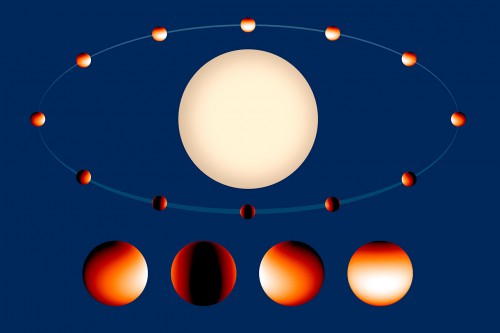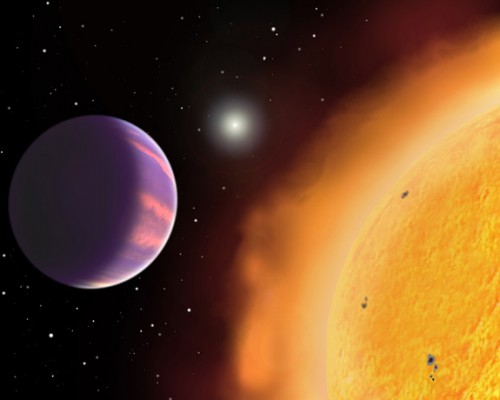
Being able to find exoplanets orbiting distant stars is a major accomplishment in itself, and fine-tuning the data enough to discover details about the characteristics of those planets is quite another. Not an easy task. Astronomers have had some initial success, but now they have been able to create the most detailed weather map for any exoplanet so far.
The weather map is the result of studies from the Hubble Space Telescope of exoplanet WASP-43b, a planet about the same size as Jupiter but with double the mass. It also orbits its star much closer than any planets in our Solar System, with a year that lasts only 19 hours. Being so close to its star, WASP-43b is classified as a hot Jupiter, a now-known type of exoplanet where large gas giant planets orbit very close to their stars, essentially the opposite of what we see in our own Solar System.
As Kevin Stevenson, from the University of Chicago and lead author of the thermal map study, explained: “Our observations are the first of their kind in terms of providing a two-dimensional map of the planet’s thermal structure. These maps can be used to constrain circulation models that predict how heat is transported from an exoplanet’s hot day side to its cool night side.”

The findings are the result of two companion studies, one which mapped the temperatures in different layers of the atmosphere, and the other which measures the amount and distribution of water vapor in the atmosphere. A detailed look at these can be seen in this video.
Unlike the Earth, the planet is tidally locked to its star, meaning it always keeps the same hemisphere facing the star, similar to how the Moon always has the same hemisphere facing the Earth. Because of this, one hemisphere is always in daylight and the other is always in darkness. The conditions are not very life-friendly, with howling winds as fast as the speed of sound moving from the day side to the night side. On the day side, temperatures can reach an estimated 1,500 degrees Celsius or more, while they plunge to a cooler 500 degrees Celsius on the night side. Probably not a good place for a vacation.
WASP-43b is without precedent in our Solar System, as explained by Nikku Madhusudhan of Cambridge University, UK:
“Because there’s no planet with these tortured conditions in the Solar System, characterising the atmosphere of such a bizarre world provides a unique laboratory with which to acquire a better understanding of planet formation and planetary physics. In this case the discovery fits well with pre-existing models of how such planets behave.”

Astronomers were able to figure out these characteristics of WASP-43b by combining two previous techniques for studying exoplanet atmospheres. Using transmission spectroscopy, looking at the host star’s light filtered through the planet’s atmosphere, they were able to determine the amount of water vapor in the atmosphere at the boundary between the day and night hemispheres. They then measured the amount of water vapor and temperature at various longitudes by using spectrum spectroscopy, where more than 99.95 percent of the light from the host star is subtracted, so that the light from only the planet itself can be analyzed.
“We have been able to observe three complete rotations – three years for this distant planet – during a span of just four days,” explained Jacob Bean from the University of Chicago, leader of the research project. “This was essential in allowing us to create the first full temperature map for an exoplanet and to probe its atmosphere to find out which elements it held and where.”
While WASP-43b does have water vapor in its atmosphere, it is not like the condensed vapor we find in clouds on Earth or even Jupiter; the planet is much too hot for that. “The planet is so hot that all the water in its atmosphere is vaporised, rather than condensed into the icy clouds we find on Jupiter,” said team member Laura Kreidberg of the University of Chicago, and lead author of the study mapping water on the planet. The fact that WASP-43b reflects very little of its star’s sunlight also indicates that there are no water vapor clouds in its atmosphere.
The new results were presented in two new papers, one on the thermal mapping of the planet’s atmosphere, published online in Science Express on Oct. 9, and the other on mapping the water content of the atmosphere, published in The Astrophysical Journal Letters on Sept. 12.
Want to keep up-to-date with all things space? Be sure to “Like” AmericaSpace on Facebook and follow us on Twitter: @AmericaSpace




The weather mapping technology will become increasingly more sophisticated leading to more profound discoveries related to the rocky, Earth-like planets. What a wonderful era of exploration we live in!